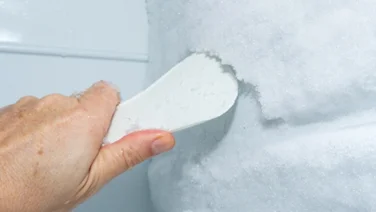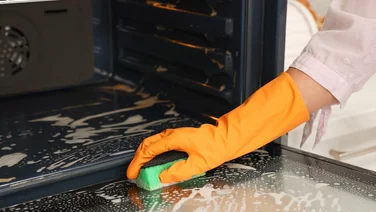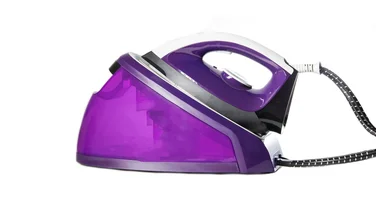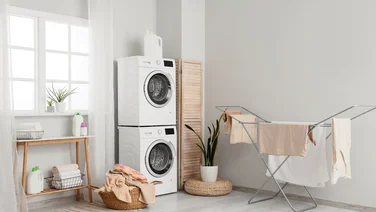To help us provide you with free impartial advice, we may earn a commission if you buy through links on our site. Learn more
- Best washing machine cleaning products: At a glance
- How to clean your washing machine
- The best products for cleaning yout washing machine
- 1. Calgon 4-in-1 Water Softener Tablets: The best all-round washing machine cleaner
- 2. HG Service Engineer Dishwasher & Washing Machine Cleaner: The best washing machine cleaner for combatting odour
- 3. Scotch Corporation Heavy Liquid Opener: Best washing machine drain unblocker
- 4. Quickshine Washing Machine Descaler Tablets: Best washing machine cleaner for preventing limescale build-up
- 5. Dr Beckmann Service-It Washing Machine Cleaner: Best smelling washing machine cleaner
- 6. Dettol Washing Machine Cleaner: The best washing machine cleaner for bimonthly use

You might never have given much thought to how to clean your washing machine. After all, you’d think your washing machine would be one of the cleanest appliances in your home. With all that detergent going in and clean clothes coming out, it must mean that a washing machine stays pristine at all times, right? Wrong, unfortunately. The pipes, seals and crevices of your washing machine, which regularly take on water, dust and dirt, actually make for the perfect breeding ground for bacteria. Besides being unpleasant and malodorous, this can also be dangerous to your health if left unchecked.
Read and we’ll explain how often you should clean your washing machine, how to investigate problem areas for dirt and build-ups, and of course, how to tackle these deposits when you find them. At the bottom of the page we’ll also list our picks for the best washing machine cleaning products for taking this task on and making things a little simpler.
READ NEXT: The best washing machines to buy
Best washing machine cleaning products: At a glance
- Best all-round washing machine cleaner: Calgon 3-in-1 | Check price at Amazon
- Best washing machine cleaner for odours: HG Washing Machine Cleaner | Check price at Amazon
- Best washing machine drain unblocker: Scotch Corporation Heavy Liquid | Check price at Amazon
How to clean your washing machine
Why do washing machines need cleaning?
Remember the reason your clothes needed washing in the first place? Exactly. All the dirt (especially the caked-on dirt) that comes off your clothes needs to go somewhere, and not all of it goes neatly down the drain: a washing machine provides a huge number of nooks and crannies in which bacteria can find a home. In addition, detergent residue can build up within the drum and powder compartments, while damp areas are always a risk for mould to grow.
There are also health risks to consider if you don’t clean your washing machine regularly, especially if most of your washes are done on relatively low temperature – say, 40 degrees or less. For example, you could become susceptible to bacteria such as E. coli and Staphylococcus aureus.
Then there’s the fact that using liquid detergents and fabric softener can cause a sticky waxy build up on the inside of the washing machine drum – again, a bigger problem when machines are mainly used at low temperatures.
Finally, people who live in hard water areas risk a build-up of limescale, reducing the efficiency and working life of the machine.
READ NEXT: How to get rid of mould on walls permanently
How often do I need to clean my washing machine?
Ideally, around once a month. If your washing machine starts harbouring mould or unpleasant smells at any time, it’s a sure sign it needs cleaning immediately.
Do I need to check the manual before I clean my washing machine?
Yes, as some manufacturers discourage the use of certain products in their machines, it could invalidate your warranty. Some manufacturers also recommend that you use a specific drum-cleaning cycle – sometimes called a service wash – to clean your washing machine.
How do I clean a front-loading washing machine?

Either use a dedicated washing machine cleaner or mix together a quarter of a cup of bicarbonate of soda and the same quantity of water in a small bowl or jug. Pour this into the detergent container – plus a cup of white vinegar into the drum – then run the machine on either a hot wash or a special service wash (if the manual recommends it). The baking soda and vinegar will naturally break up mineral deposits and mould growth, as well as sanitise and refresh your washing machine. Similarly, a dedicated washing machine cleaner will have all the ingredients required to make your machine squeaky clean. If there’s still an unpleasant smell when the cycle has finished, repeat the process (this is less likely to be necessary with a dedicated cleaner).If your detergent containers need a deeper clean, pull them out gently (checking the manual for instructions if necessary) then wash them in hot soapy water, using a clean toothbrush to get rid of any residue or mould. Then rinse and dry thoroughly before putting them back in the machine.

Finally, wipe around the rubber seals, digging deep into the crevices. If there is stubborn mould, use equal parts hot water and vinegar to wipe it away, using a cloth.You should also regularly clean the filters. For more information on how to do this, check out our full washing machine filter cleaning guide.
How do I clean a top-loading washing machine?
Either use a dedicated washing machine cleaner or mix together a quarter of a cup of bicarbonate of soda and the same quantity of water in a small bowl or jug and pour it into the machine, along with a cup of white vinegar. Then run the machine on a hot wash (special service wash if the manual recommends it). The baking soda and vinegar will handle any mineral deposits or mould while refreshing and sanitising the internals. Needless to say, a dedicated washing machine cleaner will have all the ingredients to do the same, and usually in one shot – you may need to repeat the process with our homemade formula.
If your fabric softener dispenser – or any other removable parts – need a deeper clean, pull them gently out of the machine (checking the manual for instructions if necessary) and give them a wash in hot soapy water, using a clean toothbrush to get rid of any stubborn residue or mould. Rinse and dry them thoroughly before putting them back in the machine.
What if I can’t get rid of the unpleasant smell in my washing machine?
This may mean you have a partial blockage in the standpipe, for which you’ll need to use a drain unblocker. If it’s serious, you’ll need to call in a professional repairer.
What can I do to help keep my machine fresh and clean between washes?
Grubby clothes and excess detergent are always going to cause you problems, but a few tips can help minimise the impact:
- Shake and rinse off excess dirt from soiled clothing before it goes in the washing machine.
- Don’t overload your washing machine with detergent – excess can build up inside the machine.
- If possible, use a home water softener, attached to your in-flow pipe, or tablets in your machine, especially in hard water areas – this prevents limescale build-up.
- Keep the door open between uses to allow air to flow, as well as to allow any dampness to dry, both of which prevent the build-up of mould. Pull out the detergent drawer of front-loading washing machines between uses too.
What if I live in a hard water area?
In hard water areas your washing machine will be particularly susceptible to limescale build-up, which can cause corrosion of the heating element, as well as make a comfy breeding ground for bacteria. Your best advised to add a water softening tablets to each wash and follow detergent dose instructions for hard water. You can also buy washing machine descaling products.
READ NEXT: How to descale your toilet effectively
The best products for cleaning yout washing machine
1. Calgon 4-in-1 Water Softener Tablets: The best all-round washing machine cleaner

Price when reviewed: £23 | Check price at AmazonCalgon has been a long-time favourite prevention against limescale build-up in washing machines and these tablets also protect against residue and bad smells. Just pop one in every wash, regardless of the types of fabric you’re washing, and all your washing machine parts should stay in just as good nick as they would in a soft water area. Some people find that in certain washing machines, the tablets don’t disintegrate completely on a 40 degree (or lower) wash, although we didn’t find that a problem. Luckily, while Calgon doesn’t come cheap, it does come in gel and powder alternatives which go down easier at lower temperatures.
2. HG Service Engineer Dishwasher & Washing Machine Cleaner: The best washing machine cleaner for combatting odour

Price: £9 | Buy now from Amazon
Developed in conjunction with specialist repair companies, this is cleverly marketed as a ‘virtual’ service engineer, but does it live up to the hype? Surprisingly, we think so. In fact, we found it beat other dedicated washing machine cleaners hands down, especially for machines that have become really smelly. It’s simple to use – you just pour one of the two 100ml bottles into the detergent drawer, then run it on a 60℃ wash. That’s what the manufacturers suggest, anyway; we think the 90°C cycle produces better results. Each 2x100ml pack is good for two treatments, and you can also use it to clean your dishwasher.
3. Scotch Corporation Heavy Liquid Opener: Best washing machine drain unblocker

Price: £11 (2pk) | Buy now from AmazonIf it becomes clear that you’ve got a partial blockage in the standpipe, then you’re going to need a drain unblocker. Scotch Corporation’s Heavy Liquid Opener would be our top recommendation, and indeed, other drain unblockers don’t come close. Make sure you leave it in the pipe overnight for best results, and on your next wash you should find the pipe completely free-flowing again, even just the following morning. It’s the kind of product you can’t quite believe will work as well as it does and as such, could save you a fortune in bills from a professional repairer. Better still, there’s just the bare minimum of mess and effort.
4. Quickshine Washing Machine Descaler Tablets: Best washing machine cleaner for preventing limescale build-up
Price: £7 | Buy now from Lakeland

These water soluble descaler tablets are another way of keeping your washing machine free from limescale build-up. Unlike Calgon, you only have to use one tablet once a month (or every three months in soft water areas) on a hot wash and it gently removes limescale from all key areas, including the heating element, pumps and pipes. The result? Your washing machine will work more efficiently and last longer. And if you want to double up, you can use these and Calgon as part of one cleaning routine, using the Calgon for everyday washing and these to keep everything clean and running smoothly.
5. Dr Beckmann Service-It Washing Machine Cleaner: Best smelling washing machine cleaner

Price: £3.70 | Buy now from SainburysAnother product that claims to be as good as a service, this one is particularly good at getting rid of detergent residue that forms into nasty gunk, as well as unpleasant smells and limescale build-up. Don’t use it unless your machine has a stainless-steel drum but, if it does, this should sort out even those machines that haven’t been cleaned in years. The machine we tried it on was starting to mark the laundry with brown marks, with a particularly scummy rubber seal. The seal didn’t look that different afterwards, but the rest of the machine was as good as new and the grimy marks stopped appearing on any fabrics. Plus, it smelled gorgeous. The advice is to use it every two months, which we’d say is about right for a machine that’s used at least once a day. It’s expensive, though, only giving one treatment in the box.
6. Dettol Washing Machine Cleaner: The best washing machine cleaner for bimonthly use

Price: £3 | Buy now from AmazonOne of many washing machine cleaners on the market, this one stands out for being particularly potent, which probably helps explain why Dettol suggests only using it once every two months (although it’s fine if you want to use it more). You put some on a sponge to wipe down the rubber seal, then put the remainder in the detergent drawer before running a hot wash. We found a previously dirty washing machine looked as good as new afterwards and smelt fresh too, with that smell continuing to be there after several subsequent clothes washes. Dettol claims it reaches hidden areas of the machine and kills nearly all bacteria. We’re not surprised by the claims – this is really powerful stuff that leaves you feeling that you’ve had your money’s worth.









